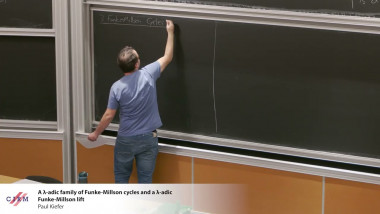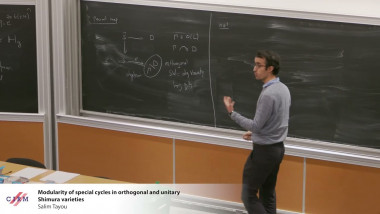
A $\lambda$-adic family of Funke-Millson cycles and a $\lambda$-adic Funke-Millson lift
By Paul Kiefer

Modularity of special cycles in orthogonal and unitary Shimura varieties
By Salim Tayou
Appears in collection : Jean-Morlet Chair - Doctoral school : Frobenius distribution on curves / Chaire Jean-Morlet - Ecole doctorale : distribution de Frobenius sur des courbes
In all the following, let an elliptic curve $E$ defined over $\mathbb{Q}$ without complex multiplication. For every prime $\ell$, let $E[\ell]= E\ell$ be the group of $\ell$-torsion points of $E$, and let $K_\ell$ be the field extension obtained from $\mathbb{Q}$ by adding the coordinates of the $\ell$-torsion points of $E $. This is a Galois extension of$\mathbb{Q}$ , andGal$(K_\ell/\mathbb{Q})\subseteq GL_2(\mathbb{Z}/\ell\mathbb{Z})$. Using the Chebotarev density theorem for the extensions $K_\ell/\mathbb{Q}$ associated to a given curve $E$, we can study various sequences associated to the reductions of a global curve $E/(\mathbb{Q}$, as the sequences $\left \{#E(\mathbb{F}_p)=p+1-a_p(E)\right }_{p: primes}, or \left \{ a_p(E)=r \right }_{p: primes}$ for some fixed value $r\in \mathbb{Z}$. For example, if $\pi_{E,r}(x)= #\left \{ p\leq x : a_p(E)=r \right }$, then it was shown by Serre and K. Murty, R. Murty and Saradha that under the GRH, $\pi_{E,r}(x)\ll x^{4/5} log^{-1/5}x$, for all $r\in \mathbb{Z}$, and $ \pi_{E,0}(x)\ll x^{3/4}$. There are also some weaker bounds without the GRH. Some other sequences may also be treated by apply-ing the Chebotarev density theorem to other extensions of $\mathbb{Q} $ as the ones coming from the “mixed Galois representations” associated to $E[\ell]$ and a given quadratic field $K$ which can be used to get upper bounds onthe number of primes $p$ such that End $(E/\mathbb{F}_p)\bigotimes \mathbb{Q}$ is isomorphic to a given quadratic imaginary field $K$ . We will also explain how the densities obtained from the Cheboratev density theorem can be used togetherwith sieve techniques. For a first application, we consider a conjecture of Koblitz which predicts that $\pi_{E}^{twin}(x):=#\left \{ p\leq x : p+1-a_p(E)\, is\, prime \right }\sim C_{E}^{twin}\frac{x}{log^2x}$ This is analogue to the classical twin prime conjecture, and the constant $C_{E}^{twin}$ can be explicitly writtenas an Euler product like the twin prime constant. We explain how classical sieve techniques can be usedto show that under the GRH, there are at least 2.778 $C_{E}^{twin}x/log^2x$ primes $p$ such that $p+1-a_p(E)^2$ has at most 8 prime factors, counted with multiplicity. We also explain some possible generalisation of Koblitz conjectures which could be treated by similar techniques given some explicitversions (i.e. with explicit error terms) of density theorems existing in the literature. Other examples of sieving using the Chebotarev density theorem in the context of elliptic curves are thegeneralisations of Hooley’s proof of the Artin’s conjecture on primitive roots (again under the GRH).Using a similar techniques, but replacing the cyclotomic fields by the $\ell$-division fields $K_\ell$ of a given elliptic curve $E/\mathbb{Q}$, Serre showed that there is a positive proportion of primes $p$ such that the group $E(\mathbb{F}_p)$ is cyclic (when $E$ does not have a rational 2-torsion point). This was generalised by Cojocaru and Duke, and is also related to counting square-free elements of the sequence $a_p(E)^2-4p$,,which still resists a proof with the same techniques (without assuming results stronger than the GRH). Finally, we also discuss some new distribution questions related to elliptic curves that are very similar to the questions that could be attacked with the Chebotarev density theorem, but are still completely open(for example, no non-trivial upper bounds exists). The first question was first considered by Silverman and Stange who defined an amicable pair of an elliptic curve $E/\mathbb{Q}$ to be a pair of primes $(p,q)$ such that $p+1-a_p(E)=q$, and $q+1-a_q(E)=p$. They predicted that the number of such pairs should be about $\sqrt{x}/log^2x$ for elliptic curves without complex multiplication. A precise conjecture with an explicit asymptotic was made by Jones, who also provided numerical evidence for his conjecture. Among the few results existing in the literature for thisquestion is the work of Parks who gave an upper bound of the correct order of magnitude for the average number (averaging over all elliptic curves) of amicable pairs (and aliquot cycles which are cycles of length $L$). But a non-trivial upper bound for a single elliptic curve is still not known. Another completely open question is related to “champion primes”, which are primes $p$ such that $#E(\mathbb{F}_p)$ is maximal, i.e. $a_p(E)=-[2\sqrt{p}]$. (This terminology was used for the first time by Hedetniemi, James andXue). In some work in progress with Wu, we make a conjecture and give some evidence for the number of champion primes associated to a given elliptic curve using the Sato-Tate conjecture (for verysmall intervals depending on $p$ i.e. in a range where the conjecture is still open). Again, this question iscompletely open, and there are no known non-trivial upper bound. There is also no numerical evidence for this question, and it would be nice to have some, possibly for more general “champion primes”, for examplelooking at $a_p(E)$ in a small interval of length $p^\varepsilon$ around $-[2\sqrt{p}]$.
